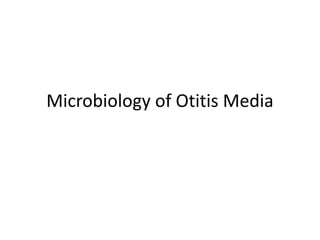More Related Content
What's hot
What's hot (20)
Upper Respiratory Tract Infection by Dr. Sookun Rajeev Kumar

Upper Respiratory Tract Infection by Dr. Sookun Rajeev Kumar
Upper respiratory tract bacterial infections 12 march 18

Upper respiratory tract bacterial infections 12 march 18
Infections of the central nervous and locomotor systems

Infections of the central nervous and locomotor systems
Viewers also liked
Viewers also liked (14)
More from SarahSaeedAhmed
More from SarahSaeedAhmed (7)
Anatomy of the cerebral circulation Week 5 objective

Anatomy of the cerebral circulation Week 5 objective
Gram staining, Culture , Antimicrobial sensitivity test

Gram staining, Culture , Antimicrobial sensitivity test
Week 12
- 1. Microbiology of Otitis Media
- 2. Otitis media • In most children, the inciting event leading to otitis media – Viral upper respiratory infection or allergy • Leading to mucosal congestion and inflammation of nose, nasopharynx, and eustachian tube↓
- 3. Microbiology of Otitis Media • Most common bacterial isolates of middle ear aspirates – Streptococcus pneumoniae – Haemophilus influenzae – Moraxella catarrhalis • Viruses (singly or as coinfectant with bacteria) – Respiratory syncytial virus – Rhinoviruses – Influenza viruses – Adenoviruses
- 4. Microbiology of Otitis Externa Organisms: Pseudomonas aeruginosa, Staphylococcus epidermidis, S. aureus, Aspergillus and Candida
